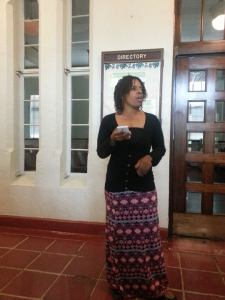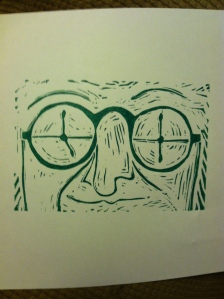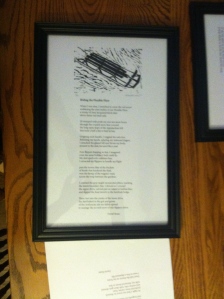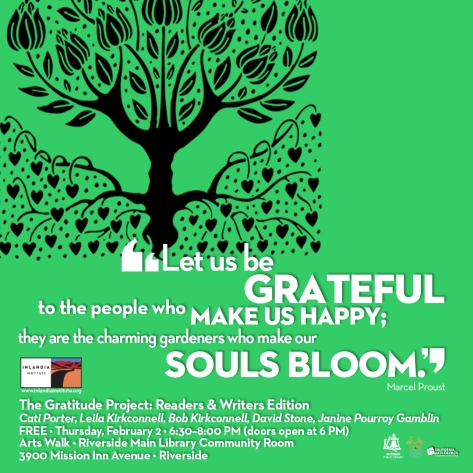
Tag Archives: Inlandia
Inlandia Literary Journeys Column
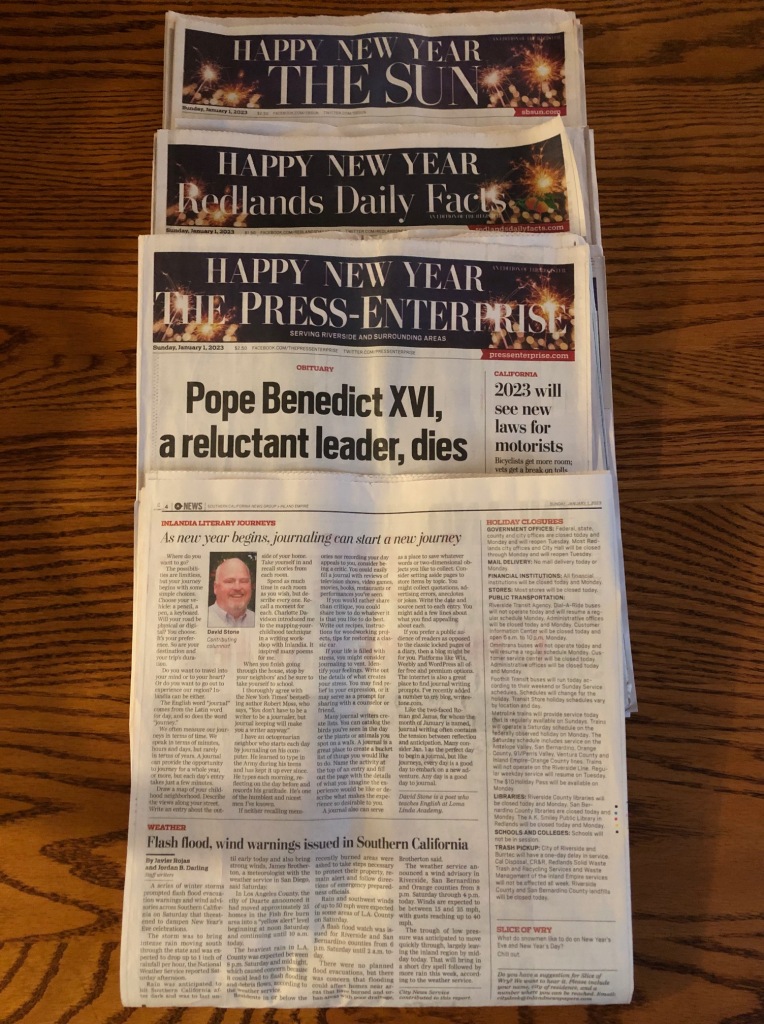
I wrote thirty-one ideas for journaling over the past month in preparation for this column’s publication. I still have more ideas that I will share later, but my streak of posts on journaling ideas will cease for now.
Today I have to make some tough decisions about which of those ideas I will actively pursue for myself this year.
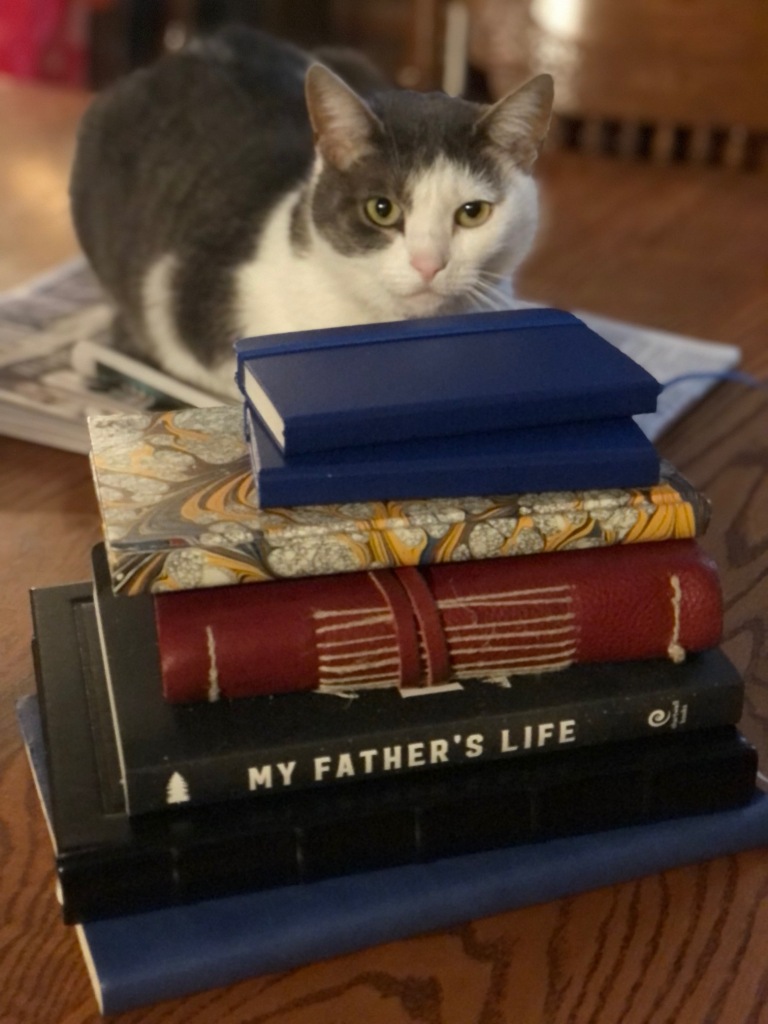
I’m going to continue occasionally to record memories of my parents in my grief turned relishing journals (blue for my mom and red for my dad). I will continue to use my black gratitude journal. I’m going to write in response to the pre-written prompts in My Father’s Life journal that my son gave me at least once a week. I’m going to start a nursery rhyme journal in the marble covered book that I have repurposed by slicing out the few pages I had started in it twenty-five years ago. I’m going to use one of the blue mini journals I got from my wife for a sentence journal and the other for my Title My Day journal. I’m going to keep going with my encourager’s journal online. I’d like to keep up with the comic journal that I started, but only occasionally.
Although I am chiding myself about only having so much time, I just overheard my wife talking to her mother about some other new journals that she has bought me for my birthday, so will see what happens.
Launch of Inlandia: A Literary Journey Tenth Anniversary Edition
Check out the tenth edition of the online journal Inlandia: Literary Journeys and my editorial interview.
End Daylight Savings Time in California.

Support California Assembly Bill 2496.
On Seeing the Cost of Time Change
Old Ben saw too many francs
burning up in France’s candle wax.
He trusted his vision.
He trusted his watch.
I am convinced of this.
I am certain of my fact.
One cannot be more certain of any fact.
I saw it with my own eyes. . . .
All the difficulty will be
in the first two or three days;
after which the reformation
will be as natural and easy
as the present irregularity,
for ce n’est que le premier pas qui coûte.
Frankly, old Ben didn’t heed
his own aphorism’s advice:
Instead of cursing the darkness, light a candle.
How could he know what he couldn’t see
when he played with his watch?
A scientist of the Age of Reason,
he didn’t know a chronobiologist.
His Junto never discussed the studies
showing traffic accidents increase
because they hadn’t heard of a car.
It’s hard to believe, Mr. Efficiency
didn’t observe workplace injuries went up.
The good French wine must have blurred
his vision and slowed his heart,
or why else didn’t he see the sharp increase
in heart attacks on the day they turned the clock.
But there’s the catch, they didn’t.
Ben’s study group was just too small,
his hubris too large, his temperament
less regulated than his watch.
his letter to the editor of the Paris Journal
doubtless of his own perceptions.
I’d like to believe Old Ben would
have felt in his gut he was wrong
if he could have flown to France
on a jet and felt the lag in his eyes
for a day, in his head for two,
and all along his digestive tract
for nearly a month. But I think
Old Ben would have been sure
it was simply the food he could see.
He wrote the editor he needn’t be paid
except with honor for his clever insight.
If Ben were still alive, I have no doubt
he’d be honored with a class action lawsuit.
The plaintiffs’ counsel would surely quote
Poor Richard’s Almanack to Mr. Franklin:
“Ignorance is not innocence but sin.”
Or maybe he’d close with the French:
Ce n’est que le premier pas qui coûte.
This is only the first step that costs.
Stone, David. “On Seeing the Cost of Time Change.” 2013 Writing from Inlandia. Riverside, CA: Inlandia Institute, 2013.
Fear, Hope, and Flight

Shortly after two this afternoon, her feet planted firmly on the floor of the Ontario Museum of History and Art, Nikia Chaney did more than walk the talk, she took flight and brought a room full of writers with her.
Chaney captivated the four tables full of workshop participants as she opened with the recitation of one of her own poems. In her rich alto voice, she pondered the removal of her wings. Far from fanciful, her words tapped into deep human fears and desires.
Waving off applause and finger snaps, saying we needed to move quickly with so many participants, Chaney quickly sought volunteers to read each of the three poems she had included on a handout: Ed Roberson’s “Here,” Langston Hughes’ “Dreams,” and Maya Angelou’s “Touched by an Angel.” She asked the participants to question: What do you fear? Why do you hope? What does it mean to fly?
Chaney gave ten minutes to write on each question. She encouraged the participants to write prose or poetry, whichever they would like. She had planned for the group to break for inspiration from the “Black Wings:American Dreams of Flight” exhibit on display at the museum through March 8th, but the number of participants prohibited it.
When thirty minutes had passed, the sharing began. Chaney encouraged initial praise and then constructive criticism. The group needed little prodding. Almost entirely women, they were highly affirming. Each participant had the opportunity to read.
Chaney saved here friend Ginger to close. With only five minutes remaining, Ginger dazzled the group with her spoken word performance.
In two hours, the group metaphorically took flight on more than twenty journeys from fear to hope and left with their own new creations.
One Man at a Women’s Club

Over thirty women filled the luncheon tables of the Beaumont Women’s Club on Sixth Street when I arrived. “Would you help us with an extra table?” asked Ruth Jennings, the Program Secretary of the Club. Getting put to work, I immediately felt like I was at a family event where the men had all escaped to another room.
A few weeks earlier, Mrs. Jennings had written me a beautiful handwritten letter in response to my Inlandia Literary Journeys column, The Lost Art of Letter Writing. She had invited me to join Cati Porter, Executive Director of the Inlandia Institute, to discuss the work of Inlandia and share some of our poems. Written on gray cotton stationary, Mrs. Jenning’s formally formatted letter described her own remarkable personal letter collection, including letters written by relatives describing scenes of the American Civil War and the funeral parade of President Garfield in 1881.
Although in my childhood my grandmother Margaret Stone was a longstanding member of the Waverly Women’s Club in Pennsylvania, and my mother, a housekeeper, had been paid to wash the dishes for that group’s meetings, I had never been privileged to view the proceedings of any of their meetings.
When the women in Beaumont stood to start their meeting by saying the pledge to the American flag as I brought in the last of the extra chairs they had asked me to retrieve from the hall closet, I paused in the door and placed my hand over my heart, feeling like a kid in school. I quickly joined Cati Porter at our back table in time to listen to the women recite the Women’s Club Pledge as they held hands. At first I felt compelled to join the women in committing to virtue and service, but hearing my own lower voice, I fell silent and scanned the room. The youngest were middle-aged like myself. The oldest, Blanche B. Fries, sat directly in front of me. At a hundred years old, she told me she still teaches piano lessons to children. She has five students.
President Joan Marie Patsky, chairing the meeting from a podium at the front, encouraged members to pass a clear plastic jug and give “Pennies for Pines.” A thoughtful member told me of the Club’s service project, how they collect money to purchase property and to plant trees. I followed the example of most of the members and emptied my wallet of some green bills and not copper. A container for a fifty-fifty raffle soon followed. One lucky member takes home half the pot, and the Club earns the rest. They asked Cati to draw the ticket for the day. The winner shouted when she determined she held the winning ticket.
Cati and I filed to the back of the room to pick up one of the antique clear glass luncheon plates with a corner raised ring to stabilize a cup. Disappointingly, no matching glass cups were set out for this meeting. I have never dined with that form of dinnerware.
Stretched over several tables were finger sandwiches, deviled eggs, crudités, sweet breads, and fresh fruit. Back at the table, I pleasantly startled myself as I ate what I thought was a pitted natural olive, but turned out to be a homemade chocolate. I enjoyed the sweet treat just before I stood up to speak.
President Patsky introduced Cati and I to the members. Cati described the mission of the Inlandia Institute to promote literary activity in the Inland Empire region of California through writing workshops, readings, and the publishing of books through Heyday Books and more recently under the Institute’s own imprint. She announced the inaugural Hillary Gravendyk Poetry Book Prize. Cati read a poem from her book Seven Floors Up inspired by a sticker that came home with her son one day, “Caution Please Do Not Turn The Head Forcefully.”
Inspired by the fine penmanship in Ruth Jenning’s letter of invitation, I began my portion of the program with “If We Stop Teaching Cursive” and “Reading Time.”
Attempting to highlight the range of Inlandia publications, I read several of my poems from the 2013 Writing from Inlandia: “On Seeing the Cost of Time Change,” “Riding the Flexible Flyer,” and “A Dammed Life.” I displayed broadside prints for each of these poems with the block print illustrations I had created.
From Orangelandia: The Literature of Inland Citrus, I read “Wishing for a Ladder” and “Redlands Sunset.” From Inlandia: A Literary Journey, the official online literary journal of the Inlandia Institute, I read “Creosote,” and “A Rare Night Air.”
I closed with “Two Eggs,” “My Father’s Amputation on Tuesday,” and “My Top Drawer.”
The members asked Cati and I numerous questions about Inlandia and the topics brought up in my poems. They also spent several minutes in animated discussion of Timothy Green’s Inlandia Literary Journeys column “Poe and Poetic Discovery.”
More than thirty years after my mother had shooed me out of the kitchen at the Waverly Community House and told me a Women’s Club meeting was no place for a boy, I decided it was a great place for a man to visit.
The Conviviality of Writers

Literary readings serve as potluck dinners for writers. Yes, the refreshment tables tantalize us and occasionally satiate, but the real feast is the words of fellow writers which nourish us, comfort us, and invigorate us.
What a pleasure to indulge yesterday on the citric words of fellow contributors to Orangelandia: The Literature of Inland Citrus at the Riverside Barnes and Noble. I so enjoyed hearing again many of this anthology’s works read by their creators and nibbling on a piece of the English shortbread made by Marion Mitchell-Wilson. Gayle Brandeis left the Inland Empire with such a legacy through this collection she edited.
If you’re shopping online for holiday presents at Barnes and Noble before November 26th, use Inlandia Institute‘s identification code (11484482) and a portion of your purchase will be given to support this non-profit arts group that offers writing workshops, readings, and so much more.
Today, I read for the first time at Fourth Sundays: Poetry at the Claremont Library. I think I counted nearly twenty poets who read to a full room. I was particularly touched by the post-reading conversations where poets shared the stories of the personal events that inspired their poems.
Serendipitously, the event was not only a great gathering of poets for an open mic, but also an annual holiday party complete with refreshments, a choice of a complementary book of poetry, and the opportunity to purchase more bargain-priced books in support of the Claremont Library, just finishing its hundredth year of service to the city. I took away Tony Hoagland’s Unincorporated Persons in the Late Honda Dynasty, Michael Chitwood’s Poor-Mouth Jubilee and four other great titles. I’m grateful for a feast of poems to enjoy over my Thanksgiving break.
Marsha Schuh Cooks Up Cardamon Rolls and Creativity at Ontario’s Ovitt Family Community Library
The Ovitt Family Community Library hosted a poetry workshop this evening with Marsha Schuh, a long time Ontario resident and poet deserving to be the city’s poet laureate.
Schuh discussed the influence of Barbara Crooker and Grant Hier on her writing. She illustrated Crooker’s thirteen ways of looking at a poem through a combination of her poems inspired by the streets of Ontario, California and her Swedish family.
Halfway through the workshop, Schuh served cardamom rolls made from her mother’s recipe and made especially “real” with butter. She graciously shared the recipe with the workshop’s attendees.
Schuh’s longest “street poem, “Geometries of Euclid,” originally appeared in Inlandia: A Literary Journey. Schuh described how she researched material for part of her poem in the Model Colony History Room of the Ovitt Family Community Library.
Schuh also demonstrated through her poem “Paradiddle” how she used “mouth-feel” and “breath architecture,” approaches she heard Grant Hier describe at a Mt. SAC Writers’ Weekend. Enjoy saying the following lines from her poem aloud: “Taradiddle nights, pepper belly moons/ xeroxed kisses in darkened rooms.”
Schuh writes accessible, tonally-rich poetry with deep feeling and meaning. She ennobles Ontario through her work.
Carving a New Block
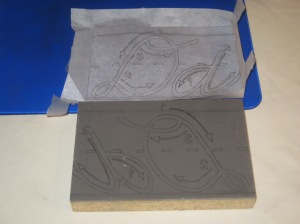
Friday afternoon I began making a new block to illustrate my poem “If We Stop Teaching Cursive.” I transferred the design to the block, and . . .

began carving the inverted design. I hope to get it finished by next week. I want to make note cards with the print on the outside and the poem on the inside with room to write.

Late last year I made three limited edition broadside prints with my own block prints. I selected three poems that were included in the 2013 Writing from Inlandia anthology. The print above illustrates “A Dammed Life.”
Orangelandia
Over a hundred and fifty people gathered at the Sunkist Activity Center of the California Citrus State Historic Park for the launch of the anthology edited by outgoing Inlandia Laureate Gayle Brandeis. Orangelandia: The Literature of Inland Citrus.
More than half of the anthology’s contributors read from the anthology which includes poetry, fiction, essays, drama, memoirs, and recipes.
Reading my own poems included in the anthology (“Wishing for a Ladder,” “Redlands’ Sunset,” and “The Navel Line”) and listening to the writings of others reminded me how much oranges are symbols of the golden dreams so many of us have formed in the fertile landscape of Southern California.


